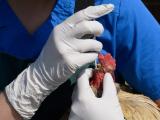Chinese health officials today announce that a 63-year-old woman from Anhui province who died in late November was coinfected with H3N2 seasonal flu and a H10N5 flu virus that is genetically related to avian subtypes.
The country's National Administration for Disease Control and Prevention posted the details on its website, which were translated and posted by FluTrackers, an infectious disease news message board.
The woman's symptoms began on November 30, including cough, fever, and sore throat. Officials said she had underlying health conditions.
Sequencing finds H10N5 has avian origin
A few days later, she was hospitalized after her condition worsened. On December 7, the patient was transferred to a hospital in Zhejiang province, where she died on December 16.
During routine surveillance on samples from fatal cases, lab scientists in Zhejiang province isolated H3N2 seasonal flu, along with the H10N5 subtype. Repeat testing at the China Centers for Disease Control and Prevention confirmed the findings.
Investigations involving the close contacts that the woman had in the two provinces found no suspicious cases, and nucleic acid tests were negative for people who were screened.
Scientists also conducted complete sequencing of the H10N5 virus and found that it was completely of poultry origin and doesn't have the capacity to easily infect humans. Officials said the woman's illness is an example of cross-species transmission from poultry to humans. The report did not say how the woman may have contracted the H10N5 virus.
Officials said the overall health risk is low and there is no sign of human-to-human transmission.
Hong Kong's Centre for Health Protection said today that it is monitoring developments with the case. "All novel influenza A infections, including H10N5, are notifiable infectious diseases in Hong Kong," it added.
First H10N5 infection in a person
China has reported a few human H10 cases before. For example, in 2013 officials reported a fatal case involving a H10N8 virus that carried genes from H9N2 avian flu, which circulates in Chinese poultry and occasionally infects humans. H10 has also been detected in Australian slaughterhouse workers and in Egyptian infants.
In 2021, China reported an H10N3 avian flu case in a man from Jiangsu province, the first known case involving the strain. He had no clear exposure to poultry, and the virus hadn't recently been detected in local poultry.
The woman's H10N5 infection appears to be the first known case in a human. Background information on influenza A virus subtypes from the US Centers for Disease Control and Prevention said most H10 infections in people have involved exposure to infected poultry.





















